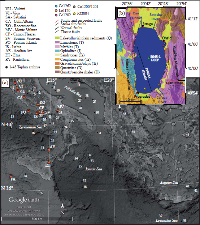First tephrostratigraphic results of the DEEP site record from Lake Ohrid (Macedonia and Albania)
Leicher N., G. Zanchetta, R. Sulpizio, B. Giaccio, B. Wagner, S. Nomade, A. Francke, and P. Del Carlo (20016).
Biogeosciences, 13, 2151–2178, doi:10.5194/bg-13-2151-2016.
Abstract
A tephrostratigraphic record covering the Marine Isotope Stages (MIS) 1–15 was established for the DEEP site record of Lake Ohrid (Macedonia and Albania). Major element analyses (energy dispersive spectroscopy (EDS) and wavelength-dispersive spectroscopy (WDS)) were carried out on juvenile fragments extracted from 12 tephra layers (OH-DP-0115 to OH-DP-2060). The geochemical analyses of the glass shards of all of these layers suggest an origin in the Italian volcanic provinces. They include the Y-3 (OH-DP-0115, 26.68–29.42 ka cal BP), the Campanian Ignimbrite–Y-5 (OH-DP-0169, 39.6 ± 0.1 ka), and the X-6 (OH-DP-0404, 109 ± 2 ka) from the Campanian volcanoes,the P-11 of Pantelleria (OH-DP-0499, 133.5 ± 2 ka), the Vico B (OH-DP-0617, 162 ± 6 ka) from the Vico volcano, the Pozzolane Rosse (OH-DP-1817, 457 ± 2 ka) and the Tufo di Bagni Albule (OH-DP-2060, 527 ± 2 ka) from the Colli Albani volcanic district, and the Fall A (OH-DP-2010, 496 ± 3 ka) from the Sabatini volcanic field. Furthermore, a comparison of the Ohrid record with tephrostratigraphic records of mid-distal archives related to the Mediterranean area allowed the recognition of the equivalents of other less known tephra layers, such as the TM24a–POP2 (OH-DP-0404, 102 ± 2 ka) recognized in the Lago Grande di Monticchio and the Sulmona Basin, the CF-V5–PRAD3225
(OH-DP-0624, ca. 163 ± 22 ka) identified in the Campo Felice Basin and the Adriatic Sea, the SC5 (OH-DP-1955, 493.1 ± 10.9 ka) recognized in the Mercure Basin, and the A11/12 (OH-DP-2017, 511 ± 6 ka) sampled at the Acerno Basin, whose specific volcanic sources are still poorly constrained. Additionally, one cryptotephra (OH-DP-0027) was identified by correlation of the potassium X-ray flourescence (XRF) intensities from the DEEP site with those from a short core of a previous study from Lake Ohrid. In these cores, a maximum in potassium is caused by glass shards, which were
correlated with the Mercato tephra (8.43–8.63 ka cal BP) from Somma–Vesuvius. The tephrostratigraphic work presented here allows, for the first time, the extension of a consistent part of the Middle Pleistocene tephrostratigraphy of Italian volcanoes as far as the Balkans. The establishment of the tephrostratigraphic framework for the Lake Ohrid record provides important, independent tie points for the age–depth model of the DEEP site sequence, which is a prerequisite for palaeoclimatic and palaeoenvironmental reconstructions. Furthermore, this age–depth model will help to improve and re-evaluate the chronology of other, both undated and dated tephra layers from other records. Thus, the Lake Ohrid record may potentially become the template for the central Mediterranean tephrostratigraphy, especially for the hitherto poorly known and explored lower Middle Pleistocene period.


